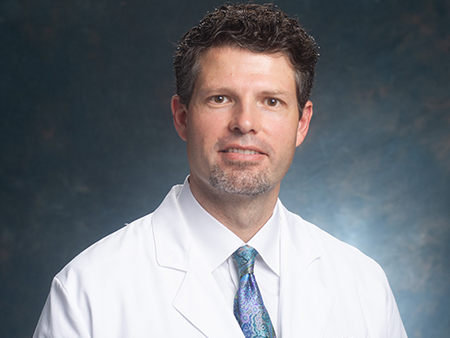 Erik Hess, M.D.Alabama hospital emergency departments have become all too familiar with patients suffering from opioid overdose.
Erik Hess, M.D.Alabama hospital emergency departments have become all too familiar with patients suffering from opioid overdose.
The state leads the nation in opioid prescriptions, according to the Centers for Disease Control and Prevention, and Jefferson County alone saw 98 deaths from heroin and 104 from fentanyl use in 2017. Opioid abuse, whether street drugs or prescriptions, is rampant.
“Emergency departments are the tip of the spear where societal problems meet healthcare,” said Erik Hess, M.D., vice chair for research for the University of Alabama at Birmingham Department of Emergency Medicine. “The nation’s opioid epidemic plays out every day in our emergency departments.”
The UAB Department of Emergency Medicine is launching a new initiative to help patients with opioid use disorders get appropriate therapy and referral for further assistance in an effort to put a dent in the epidemic. The program, called the ED MAT, or Medication Assisted Treatment Protocol, is funded by a $1.5 million grant from the Substance Abuse and Mental Health Services Administration, part of the U.S. Department of Health and Human Services.
Program partners include the UAB Center for AIDS Research and the Jefferson County Department of Health, which has undertaken a county-wide effort to coordinate care for persons with opioid use disorder.
The Jefferson County Department of Health helped establish the Recovery Resource Center, a referral hub at Cooper Green Mercy Health Services that assesses the severity of an individual’s opioid addiction, determines the intensity of treatment that is required, and coordinates referral to appropriate treatment centers, including the UAB Addiction Recovery Program, the Fellowship House, and the Beacon Addiction Treatment Center, among others.
The program has several components. The ED MAT program consists of the use of buprenorphine/naloxone in the ED to treat the symptoms of opioid withdrawal and to decrease cravings, followed by a short-term prescription of buprenorphine/naloxone if appropriate and a take-home naloxone kit.
Buprenorphine/naloxone, also known as Suboxone, is used to treat opioid use disorder. It can reduce withdrawal symptoms for 24 hours.
“It helps to lessen withdrawal so that a person feels more like their usual self, more normal,” says Hess, who is principal investigator on the project. “As they return to normalcy, they become more capable and willing to engage in treatment, which is an important first step to recovery. Studies show that Suboxone is very effective in getting patients into treatment and getting them clean.”
Patients will also be connected face-to-face with a peer navigator while in the emergency department.
“This is a hard handoff to a peer navigator – an individual in sustained recovery from opioid use disorder who has ‘been there,’ who can help the patient understand the options for continued therapy and how to maneuver through the system to access those options,” Hess said. “The emergency department is our window of opportunity to treat these patients, as many don’t tend to see medical providers outside of emergency situations.”
The navigator will assist patients with referrals to follow up treatment through the Recovery Resource Center of Jefferson County at Cooper Green Mercy Services.
“I’m elated to see that Dr. Hess and his team are able to start this innovative program,” said Mark Wilson, M.D., health officer for the Jefferson County Department of Health. “It fills a critical gap for people who are desperately seeking effective treatment for their opioid addiction or who have just survived an overdose. It will definitely save lives. I hope it can become a model that other emergency departments can replicate.”
Another component of the program will be to increase the number of physicians licensed to administer Suboxone. The Drug Addiction Treatment Act of 2000 provides a waiver for physicians who have undergone the DATA 2000 training to prescribe Suboxone. The program goal is to have 75 percent of UAB emergency physicians receive DATA 2000 waiver training. Currently only about three percent of Alabama physicians have received that training.
Program administrators anticipate enrolling 550 patients with opioid use disorder over the three years of the program.
“We’ve set ambitious goals that we think are reachable,” Hess said. “We hope to have 75 percent of our MAT clients report abstinence from opioids at six months and we aim, along with our community partners, to decrease the number of deaths in Jefferson County from opioid overdose by 30 percent over three years.”
The UAB emergency department has extensive experience integrating public service programs into ED workflow, following the creation of universal testing for HIV and Hepatitis C virus in ED patients beginning in 2011.
“We already have the necessary systems in place to identify and track these patients while we link them to appropriate follow-up care,” said Ricardo Franco, M.D., an investigator in the UAB Center for AIDS Research and co-principal investigator. “There is considerable overlap between intravenous drug use and HIV or HCV infection. This program offers a unique opportunity to have an impact on reducing not only opioid use but also the incidence of HIV and HCV infection.”
According to SAMHSA, the number of admissions for heroin in Alabama increased 220 percent from 2014 to 2017. Jefferson County’s overdose rate of 48.75 per 10,000 population was significantly higher than the statewide average of 19.9 percent per 10,000. The Jefferson County Coroner’s office reports 269 illicit drug deaths in 2017.
